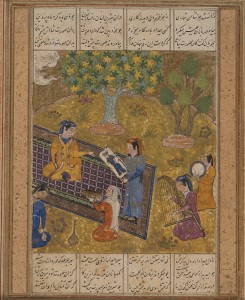The central tension of eastern and western art in My Name is Red extends to the question of representation and whether or not it is sacrilegious, but also to the desire the viewer feels towards art. One of the reoccurring motifs in the love story between Shekure and Black is the painting wherein Shirin gazes upon- and falls in love with- the painting of Hüsrev. It wasn’t until after I had finished the book that the obvious western counterpart to this tale occurred to me: King Henry VIII commissioned a portrait of Anne of Cleves, whom he was considering for a bride. Legendarily, he fell in love with the painting and took Anne for his wife. Though doubtless there were much less romantic political intercessions prompting marriage, perhaps in both love stories, the tale of people falling in love through representation is clearly part of the fabric of many cultures. Olive’s desire to see himself depicted in portrait is paralleled in the tale of Narcissus, who alike was led to his demise by the vain desire to look only upon himself. In all of these cases, the representational form becomes an intercessor or intermediary in a love affair by the mere act of looking. The gaze, which we think of as being interrupted or one-sided in the act of looking upon art, suddenly becomes completed when it meets the lover’s face.
The act of looking is imbued with power; a line from the accompanying poem found in the Khamsa of Nizami relates “the whole world became invisible to her” as Shirin examines the portrait of her beloved (Shirin Examines the Portrait of Khusraw, State Hermitage Museum). I hadn’t read any of the poem until after I finished My Name is Red, but I found this passage to be particularly evocative of the blindness that befalls the righteous miniaturist who has exhausted his sight in imitating the world through the eyes of Allah. Master Osman and Black alike wish to go blind staring at certain paintings in order to have those works of art be their last impressions of the visual splendor of the world. Black confesses that he would want to go blind staring at the painting of Shirin staring at Hüsrev. The doubling of vision and blindness is so well-crafted in this image: Black desires to lose his sight staring at the artwork he most loves, in which a woman loses her sight for everything except the portrait of the man she loves. Art is desired. Both the subject of the representation and the representation itself become objects of desire as sight and blindness both work to fix the image in memory.


Thanks for all this insight into the historical and mythical allusions Pamuk uses. There are so many intertextual references in the novel, it’s almost impossible to keep track of them or understand them all; however, I think they speak to the precision and meticulousness of Pamuk’s writing. In many ways, his writing mirrors the intricacy of illumination. Many passages are far more complex than they appear in a single reading, similar to the way works of art hold far more meaning than can be noticed at first glance.